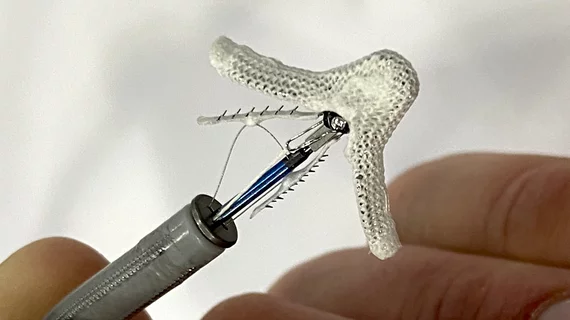Transcatheter mitral valve interventions linked to lower stroke risk than surgery
Transcatheter edge-to-edge repair (TEER) is associated with lower stroke rates than surgical mitral valve (MV) repair or replacement when patients present with severe mitral regurgitation (MR), according to a new meta-analysis published in The American Journal of Cardiology.[1] Rates of atrial fibrillation (AFib), on the other hand, appear to be similar for the two treatment techniques.
“Transcatheter MV interventions such as mitral TEER offer an alternative treatment option for patients with severe MR who are at prohibitive or high risk for surgery,” wrote senior author Dhaval Kolte, MD, PhD, an interventional cardiologist with Massachusetts General Hospital and assistant professor of medicine with Harvard Medical School, and colleagues. “The pathophysiological consequences of severe MR include left ventricular dilation and dysfunction and left atrial enlargement, increasing the risk of AFib, which in turn, increases the risk of stroke. On the other hand, both TEER and surgical interventions carry inherent risks of stroke.”
To learn more about how different treatment strategies impact these different risks, Kolte et al. explored data from more than 51,000 patients who presented with severe MR. The mean patient age was 72.2 and 60.3% of patients were men. Data came from one of 18 different studies, including 15 observational studies and three randomized clinical trials.
Overall, 40.1% of patients underwent TEER, 58.7% underwent surgical MV repair or replacement and another 1.2% received guideline-directed medical therapy (GDMT) only. While surgical MV interventions were linked to an increased risk of all-time stroke compared to GDMT alone, TEER and GDMT alone had comparable all-time stroke rates. A separate pairwise analysis confirmed TEER was linked to a lower stroke risk than surgery.
Seventeen studies included in the meta-analysis examined post-procedural stroke rates. In those studies, comparted to GDMT alone, surgery was associated with a higher risk of early stroke. TEER and GDMT alone were associated with comparable risks of early stroke. The pairwise analysis confirmed again that TEER was linked to a lower risk of early stroke than surgery.
“Our findings reveal that surgical MV interventions were associated with a 2.5- and 5.1-fold increase in the risk of all-time and early stroke, respectively, when compared with GDMT,” the authors wrote. “This elevated risk may be attributed to the more invasive nature of surgery, its prolonged duration, and the necessity for cardiopulmonary bypass, all of which escalate the potential for embolic phenomenon. To our knowledge, this systematic review generated the largest dataset to date for evaluating stroke risk after MV interventions.”
The group also examined other clinical outcomes. For example, five studies in the meta-analysis examined AFib risk; the risk appeared to be the same for TEER, surgery and GDMT alone. In addition, a total of 13 studies examined the risk of all-cause mortality one year after treatment. The risk of that outcome was lower after surgery than TEER or GDMT.
The authors emphasized that research related to this topic remains “limited and inconclusive,” meaning additional studies are still needed before any final conclusions can be made. Also, they concluded, “future studies are needed to determine strategies to reduce stroke risk following MV interventions.”
Click here to read the full study.

